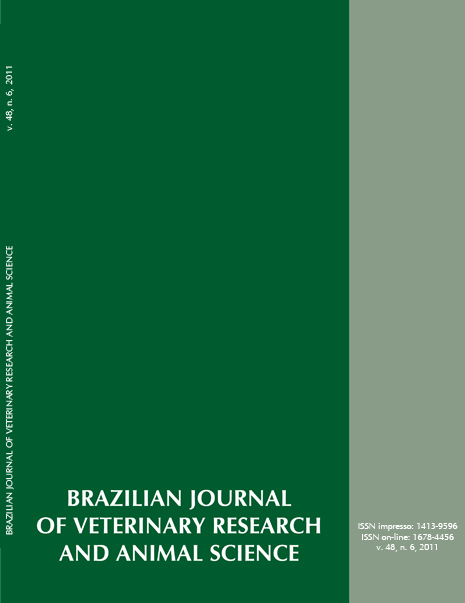Survey and identification of the epidemiological aspects of canine rabies in the city of Cuiabá-MT
DOI:
https://doi.org/10.11606/S1413-95962011000600006Keywords:
Dogs, Cuiabá, Rabies, VaccineAbstract
Known since the ancient times, the rabies is an acute infection of the central nervous system that affects mammals, caused by an RNA virus of the Rhabidoviridae family, Lyssavirus gender. Since the implantation of the urban area rabies control program in Brazil the number of cases in dogs and human have shown a decrease. In Cuiabá, the efforts to control the rabies, such as animal vaccination, focus isolation, capture of nomad animals and others realized by the Zoonosis Control Center has leaded to locking in the viral circulation in the canine species. Since 2008, zero cases of the disease in dogs were reported. In order to know the temporal distribution of canine rabies in Cuiabá - MT and identify the epidemiologic aspects of the rabies's infected dogs, and verify the canine rabies's profilatic actions of the Zoonosis Control Center of the city of Cuiabá, during the period of January, 2002 to December , 2008, the present study was performed. The historic data base from Cuiabá - MT was obtained at the Zoonosis Control Center and at the Animal Health Support Laboratory and used to perform the descriptive and observational study. During the performance of the study, 1021 samples of canine's brains were examined, 8,71% (89/1021) of them were positive and 91,29% (932/1021) of them were negative for the rabies test. The Months with higher incidence were January with 15,05% (14/93), February with 12,5% (9/72), March with 12,5% (9/72), April with 14,14% (9/72) and December with 13,69% (10/73). The major part of the infected dogs were males with 59,55% (53/89) older than two years old 50,55% (45/89) and were nomads animals 67,41% (60/89). 99,63% of the infected dogs were vaccinated in anti rabies vaccination campaigns. The vaccinal cover was higher than 80%, except in 2006. The percentual of the domiciled infected dogs by the rabies virus were 32,58% (29/89). Therefore the vaccination campaigns are essential for the immunization of a higher number of animals, and the society must be awareabout the importance of rabies and about the actions to control it.Downloads
Download data is not yet available.
Downloads
Published
2011-12-01
Issue
Section
UNDEFINIED
License
The journal content is authorized under the Creative Commons BY-NC-SA license (summary of the license: https://
How to Cite
1.
Nociti DLP, Nociti RP, Valeriano SP. Survey and identification of the epidemiological aspects of canine rabies in the city of Cuiabá-MT. Braz. J. Vet. Res. Anim. Sci. [Internet]. 2011 Dec. 1 [cited 2024 Apr. 20];48(6):478-85. Available from: https://www.revistas.usp.br/bjvras/article/view/34355





